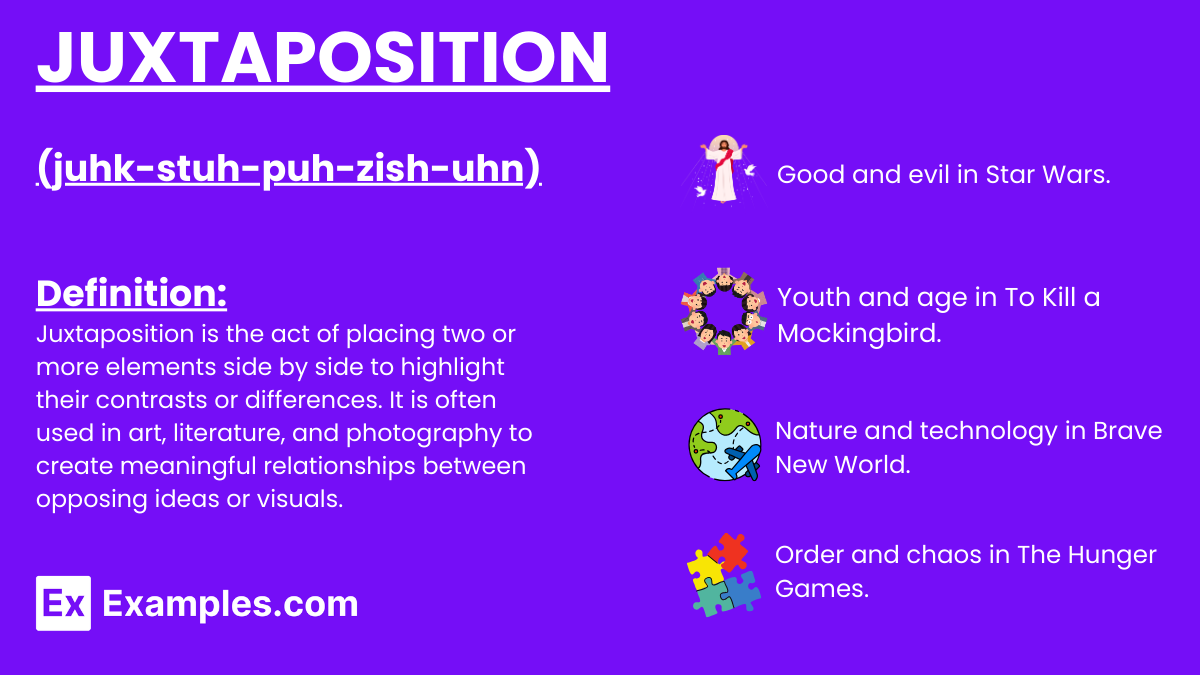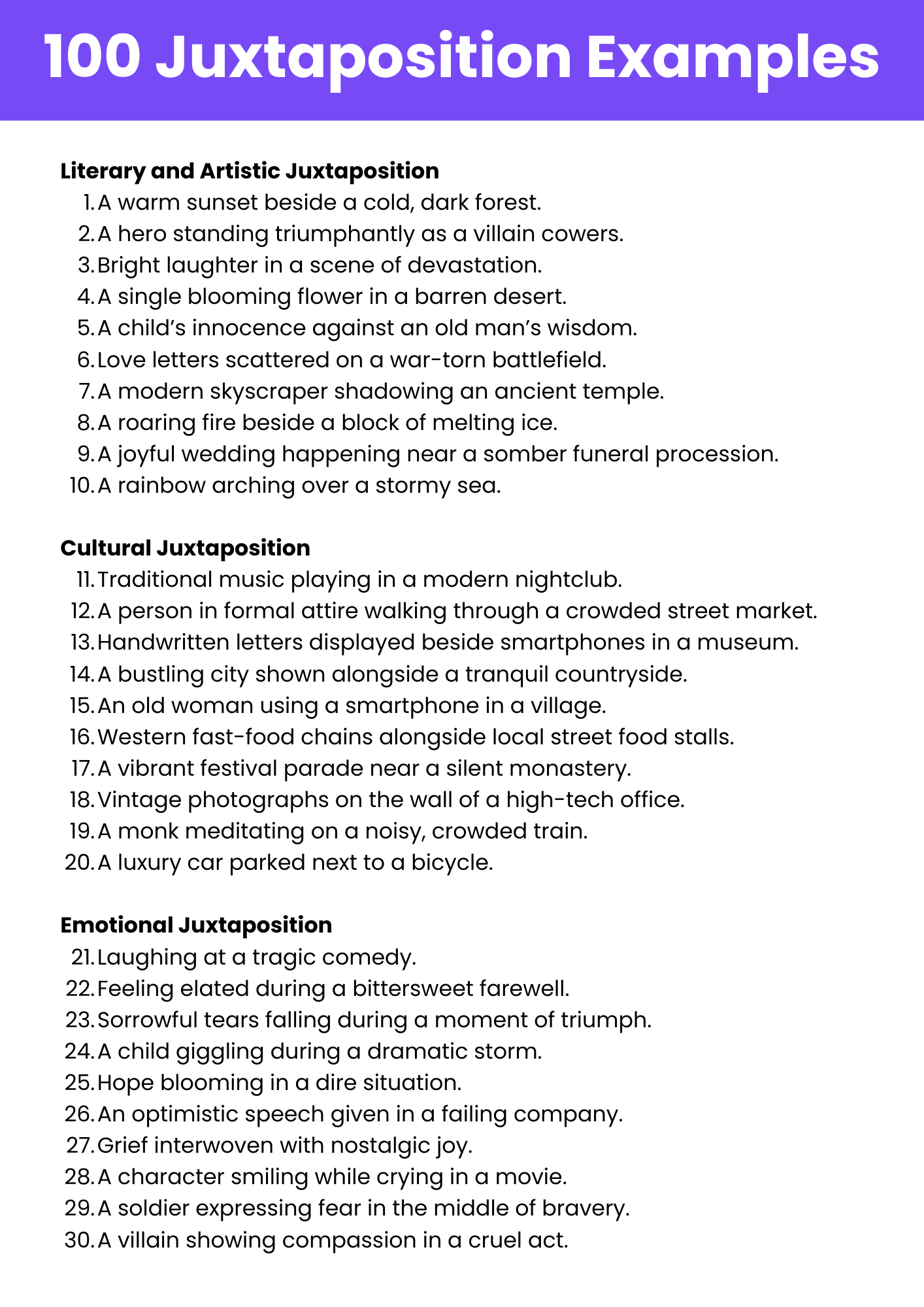Juxtaposition
What is Juxtaposition? – Definition
Juxtaposition is a literary device where two or more ideas, places, characters, and their actions are placed side by side in a narrative or a poem for the purpose of developing comparisons and contrasts. This technique highlights the differences or similarities between the elements, enhancing the overall meaning and impact of the work.

Generated Juxtaposition Examples

Download Juxtaposition Examples
Enhance your understanding with our comprehensive PDF guide.
Download PDFExamples of Juxtaposition
- Light and darkness in Macbeth
- Peace and chaos in Harry Potter
- Wealth and poverty in Great Expectations
- Hope and despair in Les Misérables
- Nature and industrialization in Heart of Darkness
- Good and evil in Star Wars
- Civilization and savagery in Lord of the Flies
- Life and death in The Road
- Freedom and confinement in 1984
- Order and chaos in The Hunger Games
- Youth and age in To Kill a Mockingbird
- Reality and illusion in Alice in Wonderland
- Nature and technology in Brave New World
- Beauty and brutality in The Lovely Bones
- Silence and noise in Silent Spring
Types of Juxtaposition
Comparative Juxtaposition
This type involves placing two similar elements side by side to highlight their similarities and differences.
- The contrasting characters of Harry Potter and Draco Malfoy in *Harry Potter* series.
- The peaceful village and war-torn city in *War of the Worlds*.
- The innocence of childhood versus the corruption of adulthood in *To Kill a Mockingbird*.
- The contrasting settings of Gondor and Mordor in *The Lord of the Rings*.
- The dichotomy of love and hate in *Romeo and Juliet*.
Symbolic Juxtaposition
This type places symbols side by side to emphasize their symbolic meanings and the relationships between them.
- The white dove and the raven in *Macbeth* representing peace and death.
- The sun and the moon in *The Great Gatsby* symbolizing Gatsby’s unreachable dreams.
- The rose and the thorns in *Beauty and the Beast* symbolizing love and pain.
- The chains and the open gates in *Animal Farm* representing oppression and freedom.
- The broken mirror and the pristine window in *The Picture of Dorian Gray* symbolizing inner corruption and outward appearance.
Thematic Juxtaposition
This type contrasts themes within a narrative to highlight differences or conflicts between them.
- War and peace in *War and Peace* by Leo Tolstoy.
- Hope and despair in *The Road* by Cormac McCarthy.
- Tradition and modernity in *Things Fall Apart* by Chinua Achebe.
- Freedom and control in *1984* by George Orwell.
- Love and hatred in *Romeo and Juliet* by William Shakespeare.
How to Identify/Find Juxtaposition?
To identify juxtaposition, look for elements that are placed side by side to highlight their differences or similarities. These elements can be characters, settings, ideas, or themes that serve to enhance the narrative by providing contrast or comparison.
- Look for contrasting elements that appear close to each other in the text.
- Identify pairs of ideas, characters, or settings that differ significantly.
- Consider how the juxtaposed elements emphasize specific themes or messages.
- Analyze the context in which the contrasting elements are presented to understand their significance.
- Evaluate the impact of the juxtaposition on character development and plot progression.
How to Use Juxtaposition?
Use juxtaposition to create contrast, highlight differences or similarities, and emphasize particular themes or ideas in your writing. This technique can add depth and complexity to your narrative, making it more engaging and thought-provoking for the reader.
- Place contrasting characters or settings side by side to highlight their differences.
- Use juxtaposition in descriptions to emphasize specific traits or themes.
- Employ juxtaposition to develop conflict or tension within the plot.
- Utilize juxtaposition to reveal deeper meanings and underlying messages.
- Ensure that the juxtaposed elements serve a clear purpose and enhance the overall narrative.
Other Literary Devices
Juxtaposition in Literature
Literary works often employ juxtaposition to highlight contrasts, develop themes, and create a more dynamic narrative through the placement of opposing elements.
- The contrasting worlds of Wonderland and the real world in *Alice’s Adventures in Wonderland* by Lewis Carroll.
- The peaceful Shire and the dark Mordor in *The Lord of the Rings* by J.R.R. Tolkien.
- The innocence of Scout and the corruption of Boo Radley in *To Kill a Mockingbird* by Harper Lee.
- The serenity of Gatsby’s parties contrasted with his underlying loneliness in *The Great Gatsby* by F. Scott Fitzgerald.
- The duality of human nature portrayed in *Dr. Jekyll and Mr. Hyde* by Robert Louis Stevenson.
Juxtaposition Examples for Kids
Introduce children to the concept of juxtaposition with simple and relatable examples that are easy to understand.
- The big lion and the tiny mouse in *The Lion King* show how different characters can be friends.
- The happy playground and the sad rainy day in *Inside Out* highlight different emotions.
- The brave firefighter and the scared kitten in *Toy Story* show courage and fear.
- The sunny day and the dark storm in *The Little Mermaid* show contrasting weather.
- The fast car and the slow turtle in *Zootopia* demonstrate speed differences.
Juxtaposition Examples for Students
Enhance students’ understanding of juxtaposition with examples that deepen their analytical skills and appreciation for literary devices.
- The coexistence of beauty and brutality in *Lord of the Flies* by William Golding.
- The juxtaposition of hope and despair in *The Road* by Cormac McCarthy.
- The clash of civilization and savagery in *Heart of Darkness* by Joseph Conrad.
- The contrast between the idyllic Shire and the destructive Mordor in *The Lord of the Rings* by J.R.R. Tolkien.
- The juxtaposition of freedom and control in *1984* by George Orwell.
Juxtaposition Examples for Class 4
Age-appropriate and relatable examples of juxtaposition for Class 4 students to grasp easily.
- The big castle and the tiny cottage in *Frozen* show different types of homes.
- The brave knight and the scared dragon in *How to Train Your Dragon* demonstrate courage and fear.
- The sunny playground and the dark cave in *Toy Story* highlight fun and mystery.
- The fast car and the slow bicycle in *Cars* show different modes of transportation.
- The bright fireworks and the quiet night in *Inside Out* illustrate excitement and calmness.
Explore Other Literary Devices
Elevate Your AP English Preparation
Unlock your potential with our comprehensive AP English exam preparation tools designed to help you excel.
- Extensive Question Bank: Access 900+ exam-like questions for both AP English Language and Literature.
- Expertly Crafted: Questions mirror the structure and difficulty of actual AP exams, ensuring relevant practice.
- Detailed Explanations: Understand your mistakes with clear, concise breakdowns of correct and incorrect answers.
- Personalized Learning: Tailor your study sessions with topic-specific tests and adaptive learning tools.
- Comprehensive Coverage: Master all aspects of the AP English curriculum with extensive guides and resources.
Frequently Asked Questions
-
What is juxtaposition in literature?
In literature, juxtaposition is a technique where two or more ideas, characters, places, or actions are placed side by side for the purpose of developing comparisons and contrasts. This method highlights the differences or similarities between the elements, thereby enhancing the thematic depth and complexity of the narrative. -
How does juxtaposition differ from contrast?
While both juxtaposition and contrast involve highlighting differences, juxtaposition specifically refers to the placement of elements side by side to create a relationship between them. Contrast is more about the differences themselves, whereas juxtaposition emphasizes the relationship and interaction between those differing elements. -
Can juxtaposition be used in visual arts?
Yes, juxtaposition is widely used in visual arts to create visual interest, highlight differences, or convey deeper meanings. By placing contrasting elements together, artists can evoke specific emotions or draw attention to particular aspects of their work. -
What is an example of juxtaposition in movies?
An example of juxtaposition in movies is the scene in *The Godfather* where the calm, serene wedding ceremony is juxtaposed with the violent undertones of the mafia operations, highlighting the duality of the characters’ lives. -
Why is juxtaposition important in storytelling?
Juxtaposition is important in storytelling because it enhances the narrative by providing depth and complexity. It allows authors to explore themes more thoroughly, develop characters by highlighting their traits through comparison, and engage readers by presenting unexpected contrasts that provoke thought and emotion. -
How can I effectively use juxtaposition in my writing?
To effectively use juxtaposition in your writing, carefully select elements that naturally contrast or complement each other. Ensure that the placement of these elements serves a clear purpose in developing your themes or characters. Use descriptive language to highlight the differences or similarities, and consider the timing and context in which you present the juxtaposed elements to maximize their impact.

